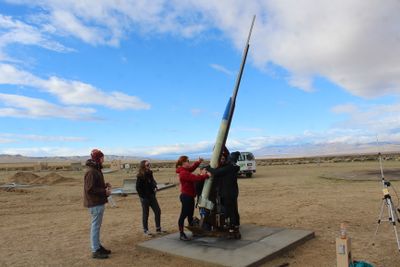Olympus 2019
Olympus 2019 was the third SSI team to compete in the Intercollegiate Rocketry Engineering Competition, succeeding IREC 2018. The rocket featured a compact avionics bay, a redesigned recovery system, a fiberglass airframe with a carbon fiber fin lay-up, and a protein crystallography payload. A liquid propulsion system was designed and tested as over the course of the year, although it was ultimately not flown in New Mexico. This liquid motor was a continuation of the prior year's Helios project, and used many of the same design principles, and Olympus 2020 is hoping to fly the liquid motor at IREC next year.
Overview
Goals and Requirements
The goal of the rocket design is to be capable of delivering an 8.8 pound payload to an altitude of 30,000 feet while employing as much student innovation as possible.
System Design
Unlike the year before, the Olympus 2019 rocket uses five-inch diameter body tubing instead of four-inch tubing. This choice was driven by the design of the tanks for the liquid propulsion system. The team also placed a much greater emphasis than past teams had put on designing all components to be as compact and light at possible.
Avionics
The avionics system consists of multiple custom printed circuit board assemblies (PCBAs), which used direct board-to-board interconnects to eliminate the use of wires. Olympus 2019 changed the layout of the avionics bay from using long vertical PCBs to be made up of a stack of circular PCBs to more minimize the size of the avionics bay.
The main boards in the avionics system are:
- Space Salmon, a rocket flight computer developed by Tim Vrakas, both for Olympus and for Spaceshot.
- COTS Carrier, a board designed by Shreya Ravi to interface a Stratologger commercial altimeter to the rest of the avionics system.
- RF Carrier, a board designed by Albert Landa which was the interface between the avionics bay, the GPS module, and the S6C long-distance radio.
- Bulkhead Board, the interface between the avionics bay and the e-match connectors, designed by Jainil Sutaria.
Recovery
The recovery system consists of the parachutes that are used to safely recovery the rocket, along with the hardware required to deploy those parachutes in flight. The recovery system uses a serial deployment system. The rocket is separated at apogee using a CO2 charge, and the drogue is deployed when the rocket separates. The main is held in a deployment bag for the majority of descent, and then is released and pulled out by the drogue at 1500ft.
In past IREC 2017 and IREC 2018 the recovery team struggled to deploy the main parachute. In 2019, the team attempted to fix this issue by loosening the deployment bag. This led to deploying the main at apogee in the first two test launches before deploying at the correct altitude on the third test launch.
Structures
Payload
Propulsion
Staging
Test Launches
Launch 1, March 2nd at FAR
Launch 1 tested all systems at some level of functionality, except for propulsion. The rocket flew to an altitude of approximately 8,000 feet. The main parachute deployed at apogee, which, along with 20 mph winds, caused the rocket to drift 3.6 miles downrange before landing.
